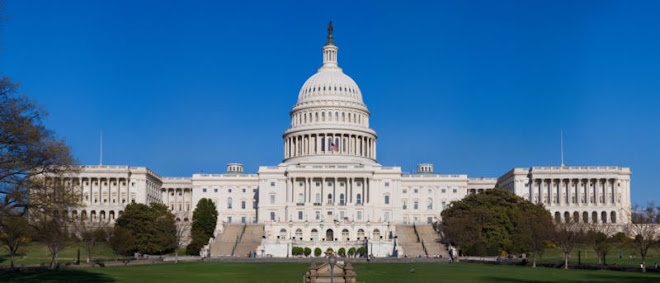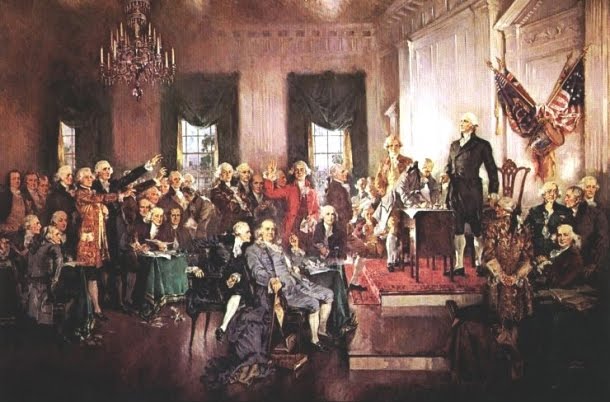From The CATO Institute:
A Look at the Senate Democratic Proposal for Immigration Reform: Is the Glass Half Empty, Half Full or Shattered on the Ground?
By Stuart Anderson, an adjunct scholar at the Cato Institute and executive director, National Foundation for American Policy.
While the new immigration law in Arizona has attracted most of the press attention, a 26-page “Conceptual Proposal for Immigration Reform” released in May by Democratic senators may be a more relevant policy development in the long run.1 The Democratic Senate document is important in two ways. First, it could be the legislative vehicle put forward in the U.S. Senate in 2010 and, as such, has a chance of becoming law. Second, even if the proposal does not become law this year it serves as an important benchmark for current and future thinking in the immigration policy debate.
Senators Harry Reid (D-NV), Charles Schumer (D-NY) and Robert Menendez (D-NJ) took ownership of the proposal and discussed the document at a Capitol Hill press conference in May. Copies of the document were soon leaked to the press and began being emailed around Washington, DC. One significant development is that Senator Lindsey Graham (R-SC) criticized the proposal, even though a month before he had co-authored an op-ed piece with Senator Schumer in the Washington Post that included a number of the same elements contained in the proposal.2 Although there is no legislative language yet to accompany the summary, there is sufficient detail to analyze the current policy direction in some key areas.
Large Increase in Enforcement Personnel in Exchange for Large-Scale Legalization
In an effort to gain support for large-scale legalization of individuals living in the United States illegally, the Democratic proposal would establish what are described as “benchmarks”—primarily hiring more enforcement personnel—that must be met before such legalization would take place. Supporters of legalization believe quantitative personnel increases can be measured—and achieved through Congressional action—as opposed to a more nebulous standard, such as certifying that the border is “secure.” The document states, “These benchmarks must be met before action can be taken to adjust the status of people already in the United States illegally.”
The precise number of new enforcement personnel is not specified in the document, which only states there would be an “increased number of Border Patrol officers,” and then uses the same language to call for “an increased number of” Immigration and Custom Enforcement (ICE) agents, worksite enforcement inspectors, document fraud detection officers, and immigration inspectors. The other benchmarks include “improved technology ... to assist Border Patrol and ICE in their missions” and increased resources to prosecute drug and immigration offenses.
It is unlikely these additional enforcement personnel would be considered necessary if Congress established a robust temporary worker visa system for lower-skilled workers. As an organization, the Border Patrol has seen the type of rapid growth in personnel normally reserved only for successful high-growth technology companies. The level of Border Patrol agents has increased from less than 4,000 in 1990 to approximately 20,000 today, a 400 percent increase in 20 years. Yet as these personnel increases have made it more treacherous to enter the country illegally, more people have decided to stay in the United States once they make it successfully across the border. As a result, the total illegal immigrant population has swelled from 3.5 million in 1990 to 10.8 million as of January 2009, according to the Department of Homeland Security.3
What About Temporary Visas?
The best way to reduce illegal immigration is to provide more legal avenues to work in the United States. If new legislation contained only a generous temporary worker program for lower-skilled jobs and nothing else, then it would do more to “control the border” than adding new enforcement personnel or the other measures contemplated in the proposal.
The good news in the proposal on temporary visas is it would include the AgJobs Act, which would reform the H-2A program for agricultural workers in exchange for providing a path to legalization for migrant farm workers now in the country illegally. However, what is given on H-2A appears to be taken away on H-2B, which are visas used for seasonal, non-agricultural jobs, such as work in resorts or picking crabs on the Maryland shore. The Democratic proposal appears to endorse a series of labor-oriented changes to current law on H-2B that would make the visas more cumbersome to use.
The proposal contains a new H-2C visa for lower skilled foreign workers. However, impact of this new visa is difficult to evaluate because the document does not give any idea as to the level of H-2C visas that would be permitted each year. The terms of the visa are three years, renewable once up to 6 years total. Individuals can change to another employer within one year, the document states, though, in general, foreign nationals on temporary visas are now able to change employers if they find a new sponsoring employer. Workers will be able to “earn lawful permanent residence if they meet sufficient integration metrics to demonstrate that they have successfully become part of the American economy and society.” This is an attempt to move the system away from relying on an employer to sponsor an individual for a green card. Without more information or legislative language it is not possible to evaluate how reliable a legal path for lower-skilled workers the H-2C visa would represent.
E-Verify and National ID Cards on the Way
If you are a fan of being fingerprinted in a federal office or obtaining permission from the federal government before you can start a new job, then this is the proposal for you. The Democratic proposal states: “Not later than 18 months after the date of enactment of this proposal, the Social Security Administration will begin issuing biometric Social Security cards. These cards will be fraud-resistant, tamper-resistant, wear resistant, and machine-readable social security cards containing a photograph and an electronically coded micro-processing chip which possesses a unique biometric identifier for the authorized card-bearer.”
This new National ID card will be paired with an electronic verification system called BELIEVE (Biometric Enrollment, Locally-stored Information, and Electronic Verification of Employment). This is intended to be the follow-on to the current E-Verify program used by approximately 3 percent of employers when hiring workers in the United States. (See Cato’s April immigration newsletter.)
This is a far-reaching proposal with many economic, fiscal and civil liberties repercussions—all designed to make it somewhat more challenging for those in the country illegally to find work. (There will still be ways for illegal immigrants to thwart the system, including, most obviously, being paid “off the books.”) Ironically, if the document’s legalization program is enacted one would think there will be relatively few people who will not be authorized to work, since nearly all of the estimated illegal immigrant population of 11 million will, in fact, become eligible to work. And, one presumes, the purpose of the large increases in enforcement personnel and other anti-smuggling initiatives is to prevent new people from entering illegally. If there is no confidence the enforcement provisions of the proposal will reduce illegal entry, then it’s not clear why members of Congress are advocating such enforcement measures become law in the first place.
In a seemingly innocuous sentence, the document states, “The Secretary of Homeland Security shall work with other agencies to secure enrollment locations at sites operated by the federal government.” What does this mean? It means the Department of Homeland Security will be overseeing the taking of fingerprints and/or other biometric data from Americans who will be required to march down to a federal office and obtain a National ID card if they wish to work in the United States.
The Neutron Bomb in the Proposal for Employers
Showing the heavy influence of organized labor, the Democratic proposal includes a provision that could wipe out any positive reforms made to both low- and high-skilled employer-sponsored temporary visas or green cards by establishing a commission to regulate business immigration.4 The proposal states: “The Commission shall have the power to declare an emergency in the immigration system. An emergency shall consist of a situation in which America’s employment-based immigration system is either substantially failing to admit a sufficient number of workers for the needs of the American economy or is substantially admitting too many foreign workers, leading to significant job displacement and/or wage depression in the American workforce. If the Commission declares that an emergency exists, the Commission shall recommend proposed adjustments in the employment based immigration system to remedy the emergency. Congress shall then be required to vote on whether to enact the Commission’s recommendations or to disapprove of enactment of the Commission’s recommendations.”
Establishing a commission makes even pro-immigration reforms difficult to evaluate. After all, commission members can later undo any decision by Congress to establish a new temporary visa, such as the H-2C visa, or provide an easier path to a green card for international students, both of which are in the Democratic proposal.
A commission is largely the brainchild of the AFL-CIO, which has endorsed the idea of a commission under the theory that a small group of appointed officials possesses the knowledge to determine the precise amount of skilled and unskilled labor the United States needs each year. It is no surprise that the AFL-CIO expects to influence who is appointed to the commission.
In reality, no set of appointed officials or other government body could accurately determine the number of professionals or workers needed in certain fields or narrow specialties. In a global economy, with a U.S. labor force of over 150 million and a gross domestic product of over $14 trillion, to even attempt such an endeavor is foolhardy. It is evident the mandate given to such a commission will be sufficiently vague such that any commission member will be able to marshal an argument that America has “too many” skilled or unskilled workers or “too many” in a particular field. The result will be more—and potentially severe—restrictions on employer-sponsored immigration
Conclusion
Overall, the Democratic proposal represents a signal to both supporters and opponents. To supporters who value legalizing the status of those in the country illegally, the proposal would fulfill such desires if it became law. To supporters who wish to establish a commission or other mechanisms to restrict employer-sponsored temporary visas or green cards, then the proposal fulfills their wishes as well.
Opponents of the measures would fall into different categories. Anti-immigrant organizations and a large bloc of members of Congress will oppose the legalization of those in the United States illegally, labeling it amnesty no matter what conditions are established. Employers should be wary of even positive reforms offered in the proposal, since members of a commission eager to show their relevance to immigration policy could override such reforms. Whether the Democratic proposal should be viewed as a glass half empty or half full—or a glass shattered in pieces on the ground—must await the arrival of legislative language.
1 Quotations in this article refer to the “Conceptual Proposal for Immigration Reform” document. A copy of the document released by the Democratic senators can be found at: http://www.nationaljournal.com/congressdaily/issues/images/graphics_2010/cd-100428-rsm-bill-outline-draft.pdf
2 Charles E. Schumer and Lindsey O. Graham, “The right way to mend immigration,” Washington Post, March 19, 2010, http://www.washingtonpost.com/wp-dyn/content/article/2010/03/17/AR2010031703115.html
3 Michael Hoefer, Nancy Rytina, and Bryan C. Baker, Estimates of the Unauthorized Immigrant Population Residing in the United States: January 2009, Office of Immigration Statistics, Department of Homeland Security, 2010, p. 4.
4 For more on the problems with a commission to regulate business immigration, see Examining Proposals to Create a New Commission on Employment-Based Immigration (Washington, DC: American Council on International Personnel, June 2009) and A Commission to Regulate Immigration? A Bad Idea Whose Time Should Not Come, National Foundation for American Policy, May 2009.
Click here to download the May 2010 Immigration Reform Bulletin (PDF).
The Cato Institute
1000 Massachusetts Ave NW
Washington, DC 20001










No comments:
Post a Comment